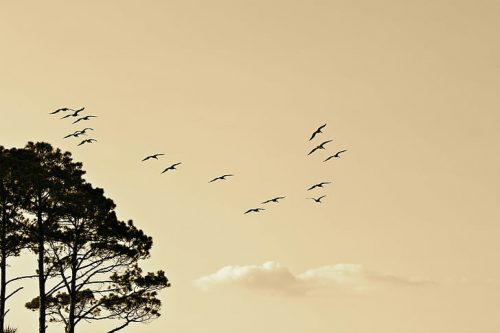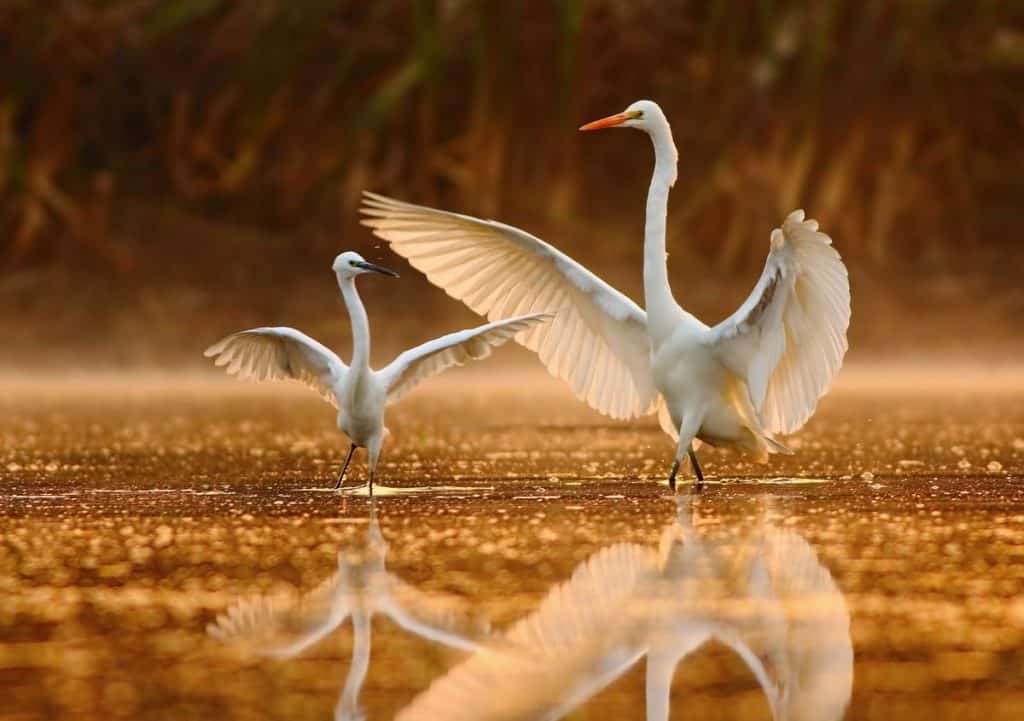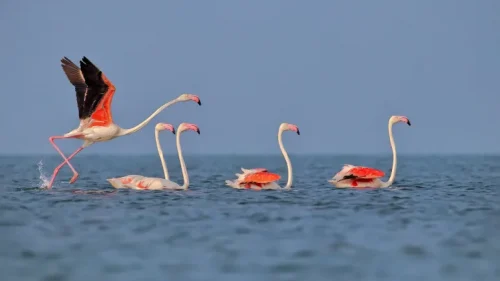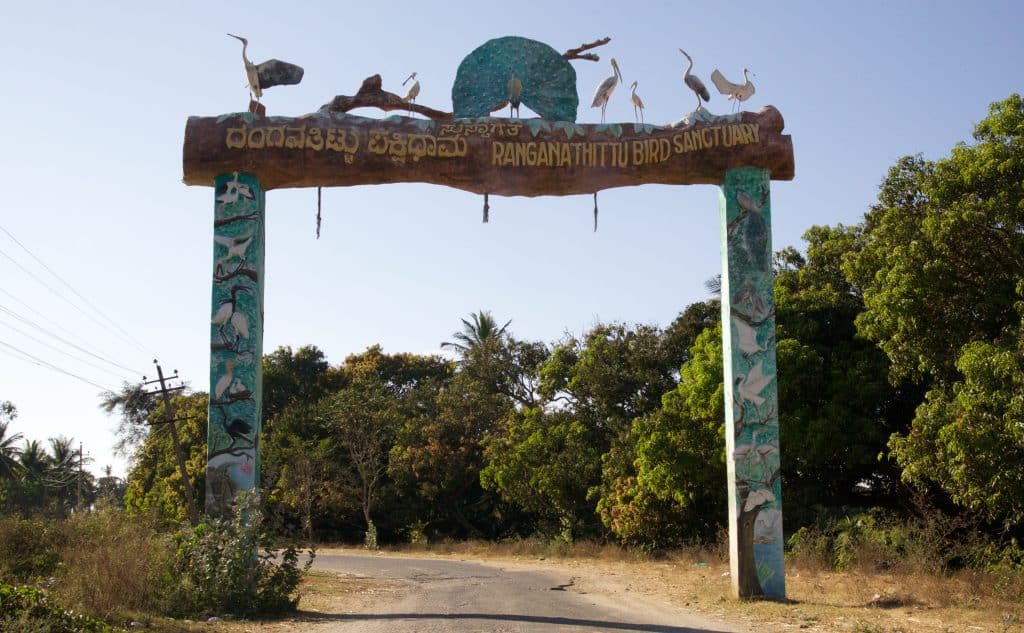Discover the best wetlands for bird watching in India featuring stunning biodiversity and scenic landscapes that promise exceptional avian sightings and enriching natural experiences.

As a bird lover in India, you’ll find yourself in the heart of biodiversity, especially in the vibrant wetlands. These areas are teeming with life and offer an unrivalled spectacle of birds in their natural habitats.
This guide is your ticket to discovering these feathered treasures, offering practical tips and highlighting exciting nearby attractions. Be Ready with your binoculars and prepare for an unforgettable adventure in India’s great outdoors.
Keoladeo National Park, Rajasthan
Keoladeo National Park in Rajasthan is a paradise for bird enthusiasts, celebrated for its extensive array of bird species. As a birdwatcher, you can spot everything from waterfowl to raptors, including the iconic Siberian Crane during its winter migration, and other fascinating species like the Sambar Deer and Painted Storks. The park also provides a habitat for numerous other birds such as the Indian Courser, the Sarus Crane, and the Grey Francolin, making it a thrilling destination for bird lovers to explore diverse avian life.

Reaching Keoladeo is quite convenient. Located in Bharatpur, it is accessible by both rail and road. The closest airport is in Jaipur, about a three-hour drive away, while Bharatpur’s railway station connects the town to several major cities including Delhi and Agra.
To enhance the travel experience, visitors can explore the rich cultural heritage of Bharatpur. The Bharatpur Palace offers a splendid display of Rajput and Mughal architecture and serves as a fascinating complement to the natural beauty of Keoladeo.
Additionally, the Bharatpur Museum presents an array of local art and history, rounding out a visit with a mix of nature and culture, ensuring a memorable and diverse adventure.
Best time to visit for birdwatching: The best period for watching resident breeding birds at the park is from August to November, whereas October to February is the ideal time to witness a variety of migrant birds.
Species Highlight: Keoladeo National Park hosts an impressive range of 370 bird species. The park is a crucial wintering ground for numerous aquatic birds from Afghanistan, Turkmenistan, Siberia, and China. It stands out as the sole location in India where the critically endangered Siberian Crane is observed during the winter months. Visitors can expect to see a variety of birds such as the pelican, cranes, wagtail, eagles, rose-ringed parakeet, painted stork, magpie robin, white-breasted kingfisher, spotted bill duck, moorhen, honey buzzard, partridge, and the green footed yellow pigeon.
Chilika Lake, Odisha
Chilika Lake in Odisha, Asia’s largest brackish water lagoon, is an idyllic spot for bird lovers, offering an unparalleled birdwatching experience. Each winter, the lake becomes a bustling hub for over a million migratory birds, making it a vibrant spectacle.
Birdwatchers can delight in sightings of rare and exotic birds such as flamingos, white-bellied sea eagles, and the elusive Irrawaddy dolphins. The lake’s Nalabana Island, a bird sanctuary within the lagoon, is particularly noteworthy for its dense concentrations of feathered visitors.

Reaching Chilika Lake is relatively straightforward. The nearest major city with an airport is Bhubaneswar, about 116 kilometres away. From there, visitors can take a scenic drive to Chilika, which offers breathtaking views along the way.
For those looking to extend their journey beyond birdwatching, the surrounding area offers numerous attractions. The ancient city of Puri, famous for its Jagannath Temple and pristine beaches, is nearby, offering cultural and spiritual enrichment.
Additionally, the artisan village of Raghurajpur, renowned for its traditional Pattachitra paintings, provides a unique glimpse into Odisha’s rich artistic heritage. Together, Chilika Lake and its environs offer a compelling blend of natural beauty and cultural exploration, making it a must-visit destination for travellers and bird enthusiasts alike.
Best time to Visit for Birdwatching: The best time to visit Chilika Lake in Odisha for birdwatching is from November to February. During these months, the lake welcomes a large number of migratory birds, making it a prime spot for observing a diverse array of avian species in their natural habitat.
Species Highlights: Between November and February, Chilika Lake becomes a prime destination for birdwatchers, attracting a wide array of migratory birds. The lake’s waters are dotted with numerous flamingos, adding a pink hue to the landscape. The skies buzz with the presence of Northern Pintails, Gadwalls, Ospreys, and White-bellied Sea Eagles. Along the shores, Black-tailed Godwits and Sandpipers abound, while rare species like the Goliath Heron and Bar-headed Goose also make an appearance.
Ranganathittu Bird Sanctuary, Karnataka
Ranganathittu Bird Sanctuary in Karnataka is a true delight for birdwatchers, known for its dense population of diverse bird species. Located on the banks of the Kaveri River, this small yet vibrant sanctuary hosts an array of both migratory and native birds. Visitors can enjoy close encounters with rare birds such as Painted Storks, River Terns, and the coveted Spoonbilled Pelican during boat rides that meander through the islets.
Getting to Ranganathittu is easy, as it is just about 19 kilometres from Mysore, which is well-connected by road and rail to the major cities of Karnataka, including Bangalore, the nearest airport city. The drive from Bangalore to Ranganathittu takes approximately three hours, making it an ideal day trip destination.

For those eager to explore beyond bird watching, the historic city of Mysore offers rich experiences, such as the grand Mysore Palace and the vibrant Devaraja Market. Also, the nearby Srirangapatna fort town, steeped in history and heritage, provides insightful glimpses into the region’s past. This combination of exceptional birdwatching and cultural exploration makes Ranganathittu Bird Sanctuary a must-visit for travellers looking to immerse themselves in nature and history.
Best time to visit for Birdwatching: The ideal time for birdwatching at Ranganathittu Bird Sanctuary in Karnataka is from December to March, when migratory birds visit, enhancing the sanctuary’s diverse avian population.
Species Highlights: Between December and March, Ranganathittu Bird Sanctuary in Karnataka teems with avian life, featuring Painted Storks, Spoonbills, Pelicans, and Kingfishers. This period also sees the arrival of distinctive migrants like the Eurasian Spoonbill and Stork-billed Kingfisher, offering exceptional birdwatching opportunities.
Pallikaranai, Tamil Nadu
Pallikaranai wetland in Tamil Nadu is a hidden gem for birdwatching enthusiasts. Located in the bustling cityscape of Chennai, this wetland is one of the few remaining natural marshlands in the region and serves as a crucial habitat for both resident and migratory birds. Birdwatchers can observe a plethora of species including the striking Flamingos, the rare Black-winged Stilts, and the colourful Kingfishers, making it a vibrant spot for photography and bird observation.
Accessing Pallikaranai is straightforward due to its proximity to the urban centre of Chennai. It is easily reachable by local transport from any part of the city, making it an accessible getaway for a day of nature and bird watching.
For those looking to explore beyond birdwatching, Chennai offers a wealth of cultural and historical attractions. The ancient Kapaleeshwarar Temple and the bustling markets of Mylapore present a deep dive into Tamil culture.
Further, the Chennai beaches, such as Marina Beach, provide a scenic backdrop for relaxation after a day of birdwatching. This mix of urban exploration and natural beauty makes Pallikaranai Wetland a unique spot for travellers who enjoy diverse experiences, blending urban charm with the tranquillity of nature.
Best time to visit for Birdwatching: The best time for birdwatching at Pallikaranai Marsh in Tamil Nadu is from October to March.
Species Highlights: From October to March, Pallikaranai Marsh in Tamil Nadu serves as a haven for a variety of bird species. The area teems with colorful Flamingos, elusive Pintails, and dynamic Sandpipers. Additionally, this season features rare appearances of the endangered Black-winged Stilt and the eye-catching Glossy Ibis, attracting birdwatchers from far and wide.
Bhigwan, Maharashtra
Bhigwan, a small town on the backwaters of Ujani Dam in Maharashtra, is often referred to as the “Bharatpur of Maharashtra” due to its fantastic bird-watching opportunities. Located about 100 kilometres from Pune, Bhigwan is particularly famous for the flocks of Flamingos that grace its waters during the winter months. Bird enthusiasts can also spot a wide variety of water birds such as the Bar-headed Goose, Osprey, and the Indian Cormorant, making it a sought-after destination for avian photographers and watchers alike.
Reaching Bhigwan is quite convenient it’s best accessed by road from Pune, which is well-connected by air and rail to major Indian cities. The drive to Bhigwan offers scenic views and a chance to escape into the tranquillity of nature.
Travellers can also explore the nearby town of Baramati, known for its vineyards that offer delightful wine-tasting tours. In addition, the ancient Bhuleshwar fort, dating back to the Yadava Dynasty era, offers a glimpse into the region’s rich history and culture. Combining birdwatching with these attractions gives visitors a well-rounded experience of Maharashtra’s diverse natural landscapes and cultural heritage.
Best time to visit for Birdwatching: The optimal time for birdwatching at Bhigwan, Maharashtra is from December to March, when migratory birds like flamingos and bar-headed geese arrive, enhancing the area’s vibrant birdlife.
Species Highlights: Bhigwan in Maharashtra is a birdwatcher’s delight, attracting species such as the vibrant flamingos and majestic bar-headed geese. The wetland also hosts a variety of ducks, waders, and raptors, including the osprey and marsh harrier, making it a rich tapestry of avian biodiversity.
Dhanauri Wetland, Uttar Pradesh
Dhanauri Wetland in Uttar Pradesh is emerging as a significant spot for birdwatching enthusiasts, especially noted for its thriving population of Sarus Cranes, the tallest flying bird in the world. Located near the city of Agra, Dhanauri offers bird lovers a chance to observe these majestic birds in their natural habitat, along with other species such as Black-necked Storks, Painted Storks, and various species of herons and ibises.
To reach Dhanauri Wetland, travellers can fly to the nearest airport in Agra or take a train to Agra Cantt Station. From Agra, Dhanauri is just a short drive away, making it an accessible day trip for those exploring the region.
In addition to birdwatching, the area around Dhanauri has much to offer. The iconic Taj Mahal and the historic Agra Fort are nearby, providing world-class architectural and historical sites for exploration. For a more immersive local experience, visitors can also explore the bustling markets of Agra, where they can shop for handicrafts and taste local cuisine.
The combination of remarkable birdwatching opportunities and rich cultural experiences makes Dhanauri Wetland a compelling destination for travellers looking to capture the essence of Uttar Pradesh’s natural and cultural splendour.
Best time to visit for Birdwatching: The best time for birdwatching at Dhanauri Wetland in Uttar Pradesh is from November to March.
Species Highlights: Notable for its thriving population of Sarus Cranes, the wetland also attracts various migratory birds like egrets, ibises, and spoonbills, creating a bustling environment for those keen to observe diverse and majestic bird species.
Magadi Lake, Karnataka
Magadi Lake, located in the bird-rich landscape of Karnataka, is a lesser-known gem for birdwatching enthusiasts. Situated just 40 kilometres from Gadag, this serene lake is particularly noted for its role as a seasonal host to the Bar-headed Goose, one of the world’s highest-flying birds. Alongside these, visitors often spot several species of waders and other waterbirds that thrive in this tranquil setting.
Getting to Magadi Lake is easy, thanks to convenient road access from Gadag, which itself is well-linked by both road and rail to major urban centres like Bengaluru. This close connection makes Magadi Lake an excellent option for a day trip from Karnataka’s vibrant capital city.
For those keen to extend their exploration, the ancient town of Lakkundi is nearby, offering a glimpse into Karnataka’s rich historical tapestry with its beautifully carved temples and step-wells. Additionally, the archaeological site of Hampi, a UNESCO World Heritage Site, is within a drivable distance, making it a perfect pairing with a birdwatching expedition.
The combination of captivating bird life at Magadi Lake and the surrounding historical sites provides a full-bodied travel experience that beautifully melds natural and cultural exploration.
Best time to visit for Birdwatching: The prime time for birdwatching at Magadi Lake in Karnataka is from December to March, when migratory birds such as flamingos and pelicans enhance the lake’s natural beauty.
Species Highlights: Dhanauri Wetland in Uttar Pradesh hosts a rich array of bird species. It is especially renowned for its significant population of Sarus Cranes. This period also sees migratory visitors like egrets, ibises, and spoonbills, making it an ideal spot for birdwatchers to explore and enjoy.
Harike Lake, Punjab
Harike Wetland in Punjab, also known as Harike Pattan, is an internationally recognized sanctuary and one of the largest wetlands in northern India. It’s a crucial stopover for migratory birds and offers an impressive array of avian species, making it a paradise for birdwatchers.
Some of the star attractions among the birds include the Indus River Dolphin, the rare and elusive species that finds a haven here, as well as more common sightings like the Pintail, Common Teal, and the majestic Siberian Crane during the migratory season.
To reach Harike Wetland, travellers can fly into the nearest major city, Amritsar, which is about 60 kilometres away. From Amritsar, the wetland is easily accessible by road. This proximity makes it a great day trip for visitors staying in Amritsar.
Besides bird watching, the area around Harike Wetland offers several enriching cultural and historical experiences. The vibrant city of Amritsar itself hosts several must-visit sites, including the Golden Temple, one of the most revered spiritual sites in India, and the Jallianwala Bagh, which tells poignant stories of India’s struggle for independence. Combining the serene beauty of Harike with the rich cultural tapestry of Amritsar offers a fulfilling travel experience, blending natural wonders with historical depth.
Best time to visit for Birdwatching: The best time for birdwatching at Harike Lake in Punjab is from October to March, when a diverse range of migratory birds, including ducks and waders, flock to the area.
Species Highlights: During the peak migratory season, around 45,000 ducks are spotted here. In the winter months, species like the wigeon, common teal, pintail, shoveler, and Brahminy ducks are frequently observed. The lake is renowned for its population of diving ducks, including the crested pochard, common pochard, and tufted ducks, which are found in large numbers. Additionally, approximately 375 bird species have been recorded in the area.
Sambhar Lake, Rajasthan
Sambhar Lake in Rajasthan, renowned for being India’s largest inland salt lake, offers a unique birdwatching experience with its picturesque landscapes and abundant avian life. This saline lake attracts a myriad of bird species, especially during the winter migration season. Bird enthusiasts can revel in the sights of flamingos, pelicans, storks, and a variety of other waterfowl that create a vibrant spectacle against the stark backdrop of the salt flats.
Reaching Sambhar Lake is convenient as it is located approximately 80 kilometres southwest of Jaipur, making it accessible by road from Rajasthan’s capital. This proximity allows for easy day trips from Jaipur or even as part of a larger itinerary through the colourful state of Rajasthan.
Beyond birdwatching, one can explore the historic town of Sambhar, which provides several cultural experiences. The Sambhar Heritage Resort offers guided tours that delve into the rich history and the salt-making process of the area. Nearby, the ancient Shakambari Devi Temple, dating back over a thousand years, offers a spiritual retreat. Combining a visit to Sambhar Lake with these cultural excursions can provide travellers with a holistic experience of Rajasthan’s natural beauty and historical wealth.
Best time to visit for Birdwatching: Birdwatching at Sambhar Lake can be enjoyed from October to March, when the lake attracts a diverse range of avian species, including flamingos, pelicans, and migratory birds.
Species Highlights: Sambhar Lake in Rajasthan offers an enchanting spectacle for birdwatchers. Flocks of flamingos, pelicans, and storks adorn its shores, while sandpipers and plovers wade through its shallow waters. Rare sightings of the majestic Demoiselle Crane add to the allure, making it a paradise for avian enthusiasts.
Nalsarovar, Gujarat
Nalsarovar Bird Sanctuary, in Gujarat, is an enchanting destination for birdwatchers. This extensive lake and marshes span about 120 square kilometres and is recognized as one of the largest wetland bird sanctuaries in India. Nalsarovar hosts an astonishing diversity of avian species, especially during the winter months when it becomes a refuge for migratory birds such as flamingos, pelicans, various species of waterfowl, and the globally threatened Sarus crane.
Reaching Nalsarovar is fairly straightforward. Located just about 60 kilometres from Ahmedabad, it can be easily accessed by road, making it an ideal day trip for those staying in Gujarat’s vibrant capital.
For those interested in broadening their travel experience, the surrounding area of Nalsarovar offers several attractions. The ancient town of Lothal, a significant archaeological site from the Indus Valley Civilization, is a short drive away and provides a fascinating glimpse into ancient urban planning and architecture. Additionally, visitors can explore the rustic charm of the local villages to observe the traditional Gujarati lifestyle and crafts. A visit to Nalsarovar promises remarkable birdwatching as well as an opportunity to understand the cultural richness of Gujarat.
Best time to visit for birdwatching: The prime time for birdwatching at Nalsarovar, Gujarat is from November to February,
Species Highlights: It is home to more than 250 species of birds including pelicans, flamingos, egrets, herons, cranes, and many more. From November to February, Nalsarovar in Gujarat becomes a paradise for birdwatchers. The lake teems with vibrant birdlife, including flocks of flamingos, pelicans, and cranes. Migratory species like ducks and geese also grace its waters, making it a captivating destination for avian enthusiasts to explore and admire.
India’s wetlands offer more than just bird watching—they allow you to experience the profound beauty and diversity of nature. Each visit not only brings new sights and sounds but also contributes to the conservation efforts that keep these ecosystems thriving.
So, pack your binoculars, charge your cameras, and set off on an unforgettable journey into the heart of India’s avian world. Whether you’re an avid birdwatcher or a curious traveller, these wetlands promise encounters that are as enriching as they are exhilarating.
Read more: Latest



